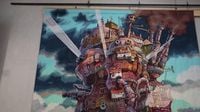The Universal Exposition opened its doors on April 13, 2025, showcasing a remarkable tapestry from Hayao Miyazaki's beloved film, Princess Mononoke, in the French pavilion. This event has drawn significant attention to the art of tapestry weaving from Aubusson, a small town in the Creuse region of France, which has been perfecting this craft for over 600 years.
Emmanuel Gérard, the director of the Cité de la Tapisserie, expressed his excitement during a video interview on April 18, 2025, just days after the exposition's launch. "The tapestry 'Ashitaka relieves his demonic wound', adapted from Princess Mononoke, is the first piece visitors see upon entering the pavilion," Gérard noted. This impressive work measures an astonishing 23 square meters, with dimensions of 5 meters in length and 4.60 meters in width, captivating visitors with its realism and intricate detail.
Since 2019, the Cité de la Tapisserie has been collaborating with Studio Ghibli, the renowned animation studio behind Miyazaki’s films, to create five tapestries inspired by their works. The current exposition serves as a unique opportunity to showcase this French craftsmanship directly to a Japanese audience, generating considerable enthusiasm among visitors. "You can see the effect of Miyazaki's work on the Japanese culture, especially among the youth who eagerly take photos of the tapestry," Gérard remarked. He believes it will become the most photographed tapestry in the collection, likely to be shared millions of times on social media.
The Cité de la Tapisserie team has been in Japan since the beginning of the week, carrying two tapestries with them. Alongside the Princess Mononoke tapestry, another piece from Spirited Away is on display in Nagoya, where it has also received a warm welcome. The Japanese have shown a deep appreciation for the craftsmanship involved in tapestry making, which was evident during a press conference held with Japanese media. "When we provide details about the creation process, they are astounded because it is something they are passionate about," Gérard explained.
This growing recognition of Aubusson's tapestry art is not just a cultural victory but also an economic opportunity. The aim is to establish economic and tourism bridges between France and Japan, specifically targeting Japanese residents in France and Japanese tour operators. "We are looking for high-end tourists, not in massive numbers, but those who will stay longer—around 48 hours—to fully experience the craftsmanship at work," Gérard said. Plans are in place to engage these visitors in hands-on experiences, such as learning how to translate animated drawings into tapestry.
Tour operators have already begun including Aubusson in their offerings, recognizing the rising interest in this unique art form. "The Japanese, who have seen the Eiffel Tower and Mont-Saint-Michel countless times, are seeking something new, and they are very interested in craftsmanship," he added. The exposure from the exposition is expected to enhance the visibility of Aubusson's rich tapestry heritage.
Gérard also shared hopes that Miyazaki himself might one day visit Aubusson to see the tapestries. However, he tempered expectations, acknowledging Miyazaki's age. "I believe he will come to see the tapestries either at the Universal Exposition or in Nagoya," he said. While there are no immediate plans for new projects, the discussions with Ghibli representatives could lead to future collaborations.
Meanwhile, back in Aubusson, the tradition of tapestry making continues to thrive. The largest manufacturing facility in the town is currently working on a state-commissioned portrait of the famous French writer George Sand, which will measure 23 meters in length and take two years to complete at a rate of five centimeters woven per day. This project highlights the ongoing commitment to preserving and promoting the tapestry craft in the region.
The artisans at the factory employ techniques that have remained unchanged since the Middle Ages, using model cartoons placed beneath the warp to guide their work. Delphine Mangeret, a cartoonist and colorist, plays a crucial role in this process, ensuring that the colors used in the tapestry reflect the emotions and meanings intended in the original artwork. "We choose the fiber and the shade based on what we want to convey in terms of both meaning and emotion," explained Nadia Petkovic, the dyer responsible for creating the perfect hues.
This intricate process not only showcases the skill involved but also the cultural significance of tapestry making in Aubusson. Tapestries can be commissioned by the state or purchased by individuals, often costing thousands of euros. The ongoing projects and the recognition gained from the Universal Exposition are pivotal in ensuring that the art of tapestry continues to flourish in the modern age.
As the exposition continues, the hope is that more visitors will appreciate the beauty and craftsmanship of Aubusson's tapestries, fostering a deeper cultural exchange between France and Japan. With the spotlight now shining brightly on this traditional craft, the future looks promising for the artisans of Aubusson and their exquisite tapestries.





